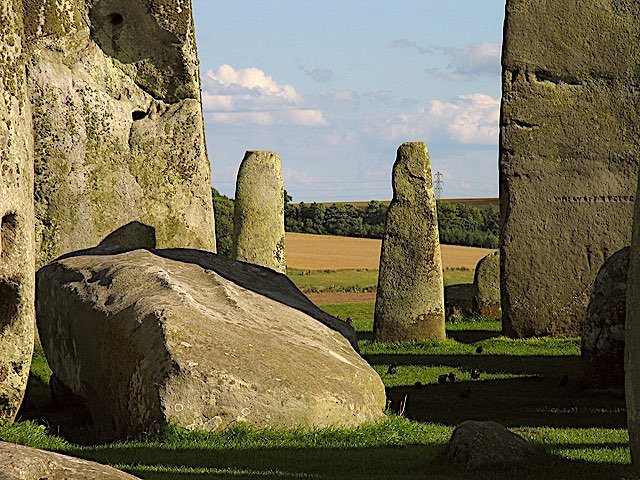On the Salisbury Plain near Wiltshire, England stands one of the world’s most captivating and recognizable prehistoric monuments, the enigmatic Stonehenge.
The UNESCO World Heritage Site, which in modern times serves as a popular gathering point on dates marking the annual Solstices, was likely constructed some time between 3000 and 2000 BC. Consisting of an outer circle of vertical standing sarsen stones that each weigh close to 25 tons, each pair is topped by a connecting lintel stone. The megalithic marvel’s outer perimeter of stones encircles an inner ring constructed of smaller bluestones, at the center of which rests an additional array of vertical stones joined by lintels.
Stonehenge has long captured the imaginations of visitors from around the world and remains widely regarded as one of the world’s most mysterious ancient sites. Now, a team of researchers with Aberystwyth University’s Department of Geography and Earth Sciences thinks they may have unraveled additional clues about one of the famous site’s long-kept secrets: the origins of its enigmatic Altar Stone.
Mystery of the Altar Stone
Stonehenge stone 80, nicknamed the “Altar Stone,” has long remained a focal point of the megalithic site’s enduring mystery. Weighing close to six tons, the stone, if standing vertically, would have stood around two meters tall, although opinions about whether the stone was ever positioned vertically remain mixed among those who have studied the site.
More central to the Altar Stone’s mystery are its origins, since the stone is comprised of materials that are not local to the surrounding area. Although most of the material used to construct the monument is believed to be sourced from a quarry location 140 miles away—a significant distance for the materials to have been carried by Britain’s early inhabitants—the Altar Stone’s composition suggests that it traveled an even greater distance before it arrived at the center of England’s most famous archaeological site.


Now, Richard E. Bevins, Nick J.G. Pearce, and other team members with Aberystwyth University report newly published findings they say could upend a century-old theory about the site’s mysterious Altar Stone, adding a new layer of intrigue to one of the site’s many curiosities.
Revealing the Altar Stone’s Secrets
Composed primarily of sandstone, the Altar Stone contrasts sharply with the igneous bluestone that forms the site’s surrounding stonework, which when wet take on a characteristic bluish hue.
Theories have long held that the Altar Stone likely came from the 400-million-year-old Old Red Sandstone formation, a portion of which is located in west Wales, not far from the Mynydd Preseli area where the site’s bluestone originates. Believed to have been created when Europe and North America collided hundreds of millions of years ago, portions of the same sandstone formation can be found as far away as Greenland, Norway, and America.
Team members with Aberystwyth University decided to conduct analyses of the Altar Stone using optical petrography, Raman Spectroscopy, and a range of other technologies to view samples obtained from the Old Red Sandstone formation, which is notably high in barium content; a factor that quickly distinguishes it from the surrounding bluestone nearby.
By comparison, samples taken from the Altar Stone revealed something interesting: an unusual barium content and differing mineral content that sharply contrasts with samples from west Wales. According to the research team, their findings suggest that the Altar Stone was not retrieved from the Old Red Sandstone formation, and probably originates from an undetermined location someplace much further away.
The team suggests searching for much younger English sandstone formations in order to find a match for the unique composition displayed in analyses of samples from the Altar Stone.
Stones of Foreign Origin
Even the earliest excavations at Stonehenge led to the bluestone portions of the monument being dubbed “foreign stones” due to their obvious difference from the local indigenous stone.
While many of the larger stones used in portions of the site’s outer ring are thought to have been sourced from locations just 15 miles away, most of the bluestones can be traced to the Mynydd Preseli area 140 miles west of Stonehenge.
This feat of transportation is itself one of the enigmas about Stonehenge since transportation of bluestone slabs of that size during the period the site is believed to have been constructed represents the greatest distance such large stones from a recognized source were carried to their eventual resting place anywhere in the ancient world.
The amount of work this would have required has led to speculation in the past that the stones might not have been carried by humans at all. In 1971, geologist Geoffrey Kellaway suggested that the bluestones used at the site might have been carried to the Salisbury Plain as a result of glacial movement that occurred there in the distant past, effectively making them what geologists call erratics.
Kellaway’s theory, featured in a study that appeared in the journal Nature, argued that there was no evidence of similar transportation of stones so massive anywhere else in the archaeological record of the British Isles, or anyplace else, for that matter. However, evidence of glaciation on the Salisbury Plain would be plainly evident if natural forces strong enough to have carried bluestone slabs across great distances had taken place there in the past. Unfortunately for Kellaway and his theory, such evidence is lacking.
Upending a Century-Old Stonehenge Theory
Based on its unique mineral composition, the Altar Stone remains more than merely another “foreign stone” in the famous monument’s ancient collection. According to the Aberystwyth University research team, their new findings effectively remove the link to the Mynydd Preseli-derived bluestones found at the site altogether. But if it also couldn’t have been transported by glacial movement as Kellaway suggested in the 1970s, that would seemingly mean that humans must have done the heavy lifting, and over an even greater distance than once believed.
In light of the new findings, many questions remain about what the Altar Stone’s actual source may have been. However, the fact that it was likely sourced from an even greater distance away than previously thought—and thereby required transportation from much further afar—only strengthens the contention that the mysterious builders of Stonehenge were very capable architects, who seemingly did not place convenience over whatever motivations may have driven their search for the perfect stones used in constructing one of the greatest marvels of the ancient world.
The new paper, “The Stonehenge Altar Stone was probably not sourced from the Old Red Sandstone of the Anglo-Welsh Basin: Time to broaden our geographic and stratigraphic horizons?,” was published in the Journal of Archaeological Science.
Micah Hanks is the Editor-in-Chief and Co-Founder of The Debrief. He can be reached by email at micah@thedebrief.org. Follow his work at micahhanks.com and on Twitter: @MicahHanks.

